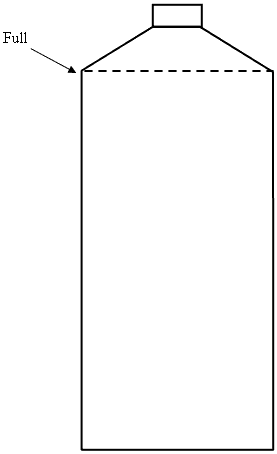Filling bottles
Shade each of the milk bottles below to show where the level of milk would be.
|
a) Shade this bottle to show it is 45 full
|
b) Shade this bottle to show it is 410 full
|
| Y6 (11/2006) | |
Students' responses were coded into regions on the milk bottle as follows:
|
a) easy b) easy |
Based on a representative sample of 139 students.
A marking template, which can be copied onto acetate, is provided at the back of this resource.
NOTE:
- Students shaded the bottle as either < or > 1/2 .
- The difficulty levels for students at Y4 were a) very difficult, and b) very difficult
The most accurate answers were achieved by students who showed some evidence of how they partitioned the milk bottle into equal parts before drawing their answer.
| Common error | Likely misconception | |
|
a)
b) |
Draws a mark in region D 4/5 < 1/2 4/10 > 1/2 |
Part-whole misconception of fractions This could indicate that students don't know how to show a fraction as a part of something. They may not be aware what the "whole" is, and are trying to find a fraction of some other "part", e.g., finding 4/5 of "half" the milk bottle. |
|
a)
b) |
Draws a mark in regions B or C 4/10 > 1/2 4/10 < 1/2 |
Lack of a method to ensure accurate representation of fractions |
Students may "guess" where the milk level is so it is important to encourage students to:
- explain how they worked it out;
- explain how they know their method works (critique their answer and strategy); and
- show this using diagrams, symbols or writing.
Students who indicated Region D may also need more exposure to understand that the top and bottom numbers in a fractional number show a part-whole relationship.
These students could:
- investigate what the top and bottom numbers actually mean;
- explore fractions of 2-dimensional shapes (and partitioning if required);
- try some simple fractions on a blank milk bottle, asking:
"How far is half way up the bottle?",
"How far up the bottle is this? [Indicating simple fractions]".
Students whose responses lay in regions B or C may need to clarify what "whole" they are finding the fraction of.
- Investigate how they know that is where the mark is supposed to be, and how they could check that this is correct.
- Encourage them to show how they constructed the answer, e.g., partitioning the milk bottle into equal parts and then adding each unit fraction to make the fraction shown.
"If the bottle was half full where would the mark be?", and "… a quarter full?",
"how far up the bottle is 1/5 (or 1/10)?", and then count up to 4/5 (or 4/10).
Marking template
Photocopy onto acetate and use to mark students work.




